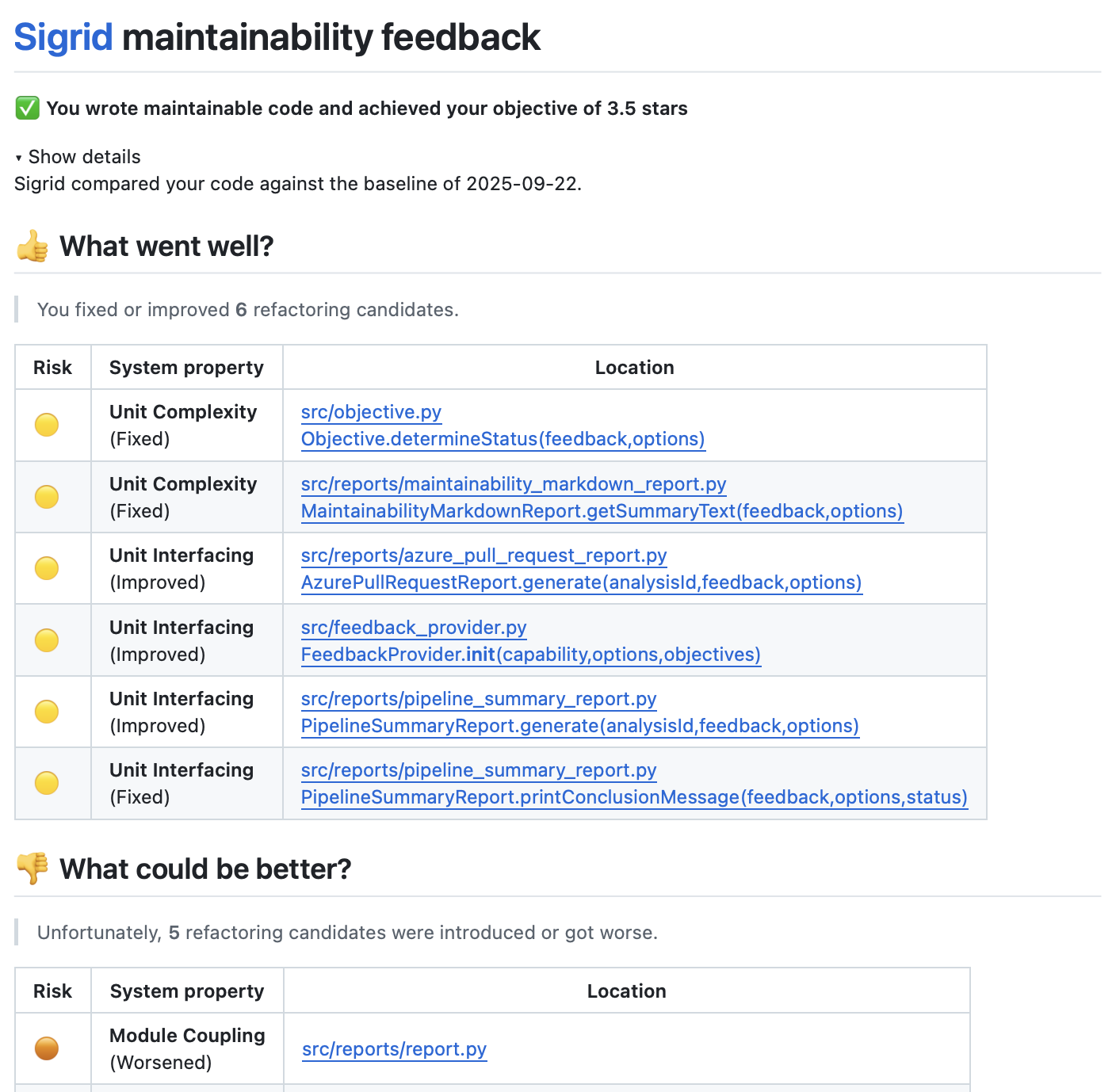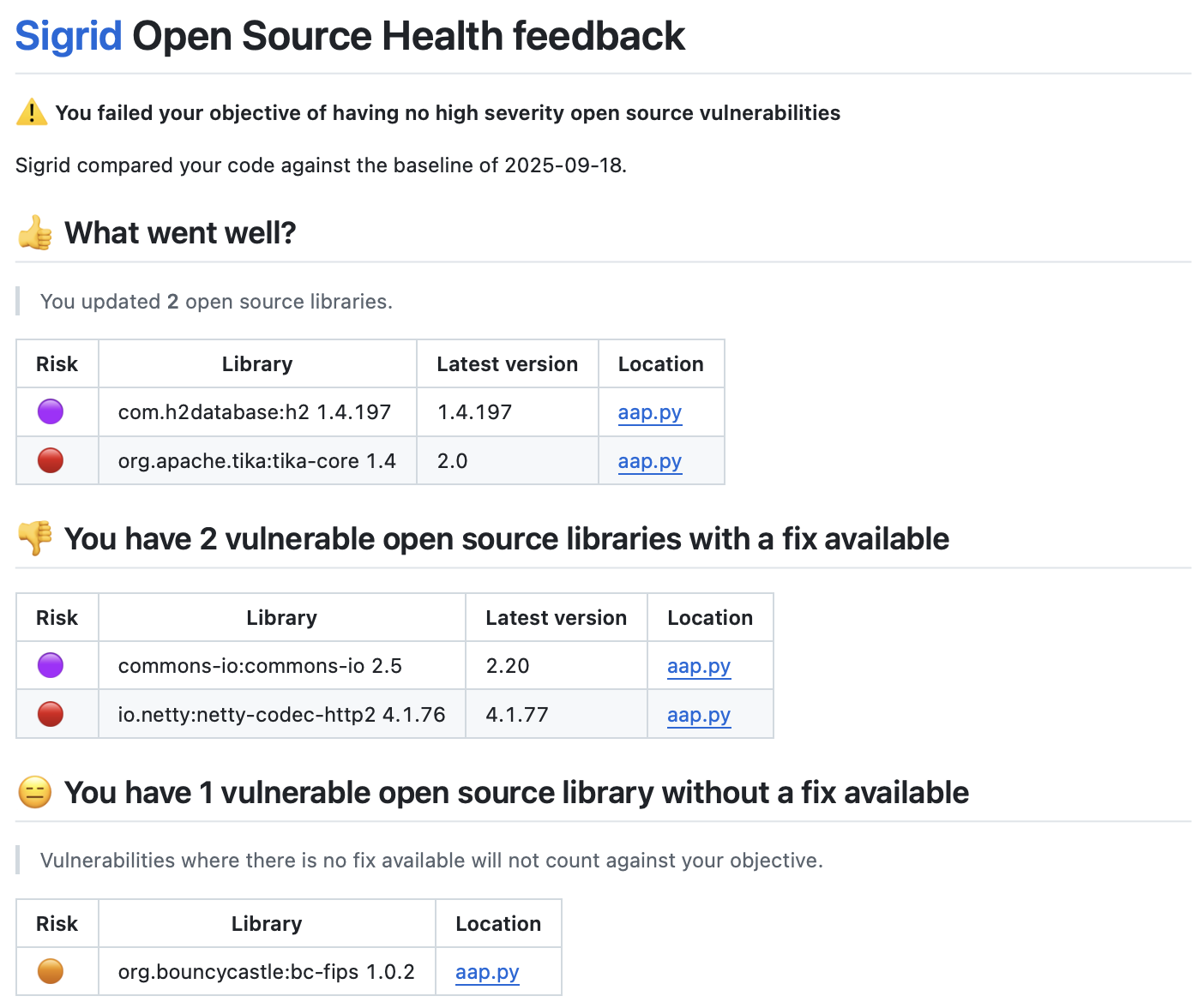Using Sigrid CI
This page is about interacting with Sigrid CI from a user perspective. If you’re looking for instructions on how to integrate Sigrid CI in your development platform, locate the “Sigrid CI: Pipeline integration” in the menu. See the option reference if you want to know which configuration options are available.
Sigrid CI does two things:
- Sigrid CI publishes code to Sigrid. This integration makes it easier to keep your Sigrid up-to-date, since changes to your code are automatically reflected in Sigrid.
- Sigrid CI provides feedback on your changes. This allows development teams to consume this feedback as part of the normal development process.
In a typical development process, step 1 would take place whenever you merge something into your main/master branch, and step 2 would apply to your pull requests. If you’re using a different process, this documentation contains guidelines on where and how Sigrid CI can be used in different development processes.
The remainder of this page is about how Sigrid CI gives feedback.
How does Sigrid CI give feedback?
Sigrid CI gives you feedback on different quality aspects. You can find more information on our feedback for Maintainability and Open Source Health in the sections below. However, there are also some shared principles we apply across Sigrid CI:
- Focus on objectives: All Sigrid CI feedback relates your changes to the objectives you’ve defined in Sigrid. Objectives provide context. It’s not reasonable to expect the same level of quality for a legacy system as for a brand new mission-critical system. Objectives allow you to provide this context, so that every system gets a target that is both reasonable and achievable. Using objectives also means there is a common thread between what you see in your pipeline versus what you see in the management dashboard, which helps to make different stakeholders in the IT organization have a shared perspective.
- Strive for good, not for perfection: It’s not realistic to expect teams, who often already have a high workload, to be able to fix every single issue right away. This is another area where defining objectives help you to set a baseline on what you consider good-enough quality.
- Don’t forget about positive feedback: Sigrid CI feedback is split into categories that should be familiar to anyone who has participated in an agile retrospective: What went well and What could be better. We intentionally start with the positive feedback, to put the emphasis on how people improved technical debt. This helps to create a culture of quality awareness, and helps to point out that we see and appreciate people’s efforts, and that we don’t just want to flood them with endless lists of stuff they need to work on.
Maintainability feedback
Maintainability feedback follows the feedback structure introduced in the previous section. When it comes to your objective, Sigrid CI will let you pass as long as you’re moving towards your objective. As long as you keep making incremental improvements in the right direction, you’ll get there eventually. This approach means Sigrid CI is generally “nicer” than tools that require you to fix every single issue right away.

The reason Sigrid CI is “nice” is to encourage refactoring during normal development. Let’s say you’re working on a normal, functional ticket. You find the file you’re changing is full of technical debt. Ideally, you would try to perform some minor refactorings while implementing your ticket. Obviously, we don’t expect you to fix everything, that would not be reasonable. The behavior we’re going for is known as the boy scout rule, where you should leave your code (or your campsite) cleaner than you found it.
Open Source Health feedback (Beta)
Sigrid CI gives feedback on security vulnerabilities in open source libraries. Sigrid also checks other aspects of using open source libraries, such as licenses and freshness, but those are not part of Sigrid CI. So why is this different? In practice, people find updating open source libraries to address security vulnerabilities much more urgent than those other aspects. Obviously, you should still manage those other aspects, as explained in our guidelines for healthy use of open source libraries, but addressing vulnerabilities is something that typically needs to be addressed immediately.
Sigrid CI does not require you to update every single open source library to address every single vulnerability. Which vulnerabilities are allowed versus not allowed is decided based on your objectives. This means you can use a different objectives dependent on the (type of) system. For example, you can decide to prevent high or critical severity vulnerabilities in public-facing systems, but only prevent critical vulnerabilities for internal systems.

Unlike the feedback for maintainability, you really do need to address every single vulnerability that’s blocking your objective. This is because of a difference in urgency between maintainability and security: Maintainability is more of a “chronic” problem, while security threats are “acute” and really do need to be mitigated right away.
Sigrid CI separates vulnerable open source libraries into two categories:
- Vulnerable libraries for which a fix is available: These have a straightforward mitigation: Update the open source library, ideally to the latest version, but at minimum to a version that is no longer vulnerable.
- Vulnerable libraries for which no fix is available: These cases are more difficult to manage, since there is no obvious solution or mitigation. These cases typically require more discussion on the exact details of the vulnerability and possible follow-up actions. This is explained in more detail, also from a process perspective, in our guidelines on using open source.
Adding Open Source Health feedback to an existing Sigrid CI configuration
- All platforms: You need to add the option
--capability maintainability,oshto the Sigrid CI step in your pipeline configuration. - GitHub: In addition to the above, you need one extra step: In your pipeline configuration, look for the
line
message-path: sigrid-ci-output/feedback.md, and change this tomessage-path: sigrid-ci-output/*feedback.md. Adding the asterisk allows you to get feedback on all Sigrid capabilities, not just maintainability.
How do you deal with feedback from Sigrid CI?
Feedback from Sigrid CI is intended to be used in the context of a pull request. Pull requests typically involve two participants, the author and the reviewer, and both can use this feedback. When working on the pull request, the author can use the feedback to make some corrections before asking for a review. When the pull request enters the code review, the reviewer can use the feedback as part of his or her review.
Should you block your pipeline?
If you ask us: No. Any form of automated feedback will occasionally lead to results that are unfair, and Sigrid is no different. As explained above, we ideally want Sigrid CI feedback be used as input for a code review, with the reviewer making the final call on whether to approve the review.
Still, we concede there are situations and organizations where you really do want to make Sigrid CI a mandatory check. Therefore, we do provide the option to fail the pipeline if Sigrid objectives are not met. You can configure this to make the pipeline fail on any Sigrid objective, but you can also make this behavior more nuanced by failing the pipeline on certain types of objectives. The latter is configured using exit codes, as explained here.
Contact and support
Feel free to contact SIG’s support department for any questions or issues you may have after reading this document, or when using Sigrid or Sigrid CI. Users in Europe can also contact us by phone at +31 20 314 0953.

